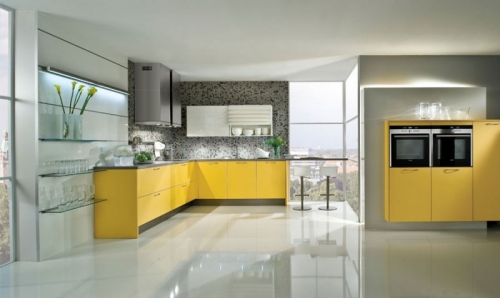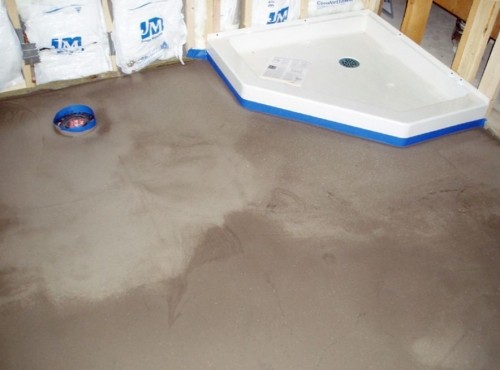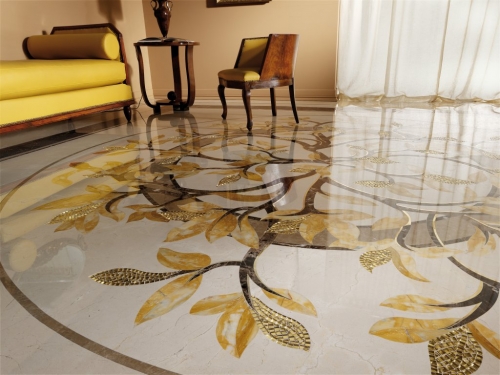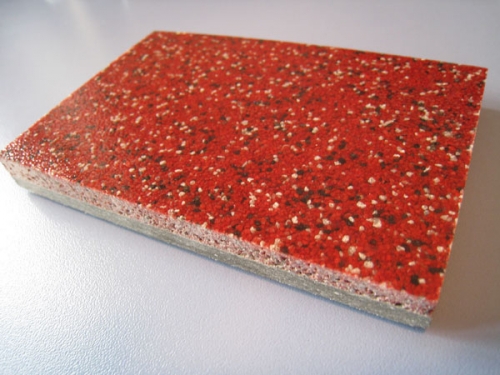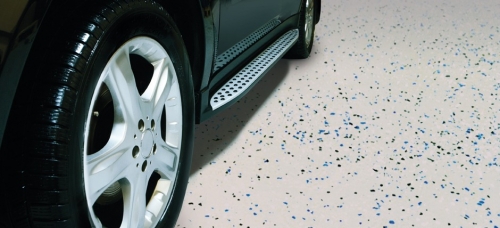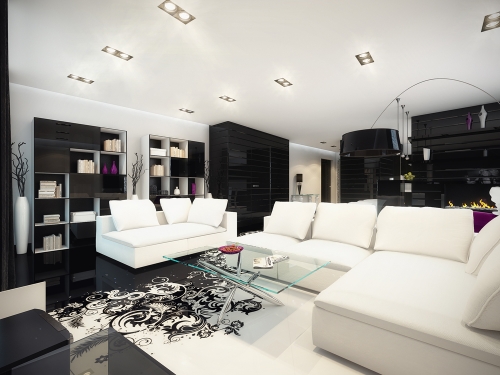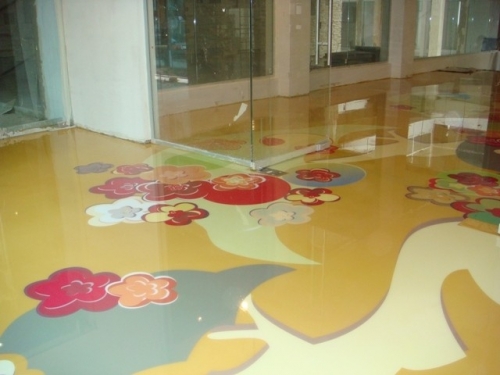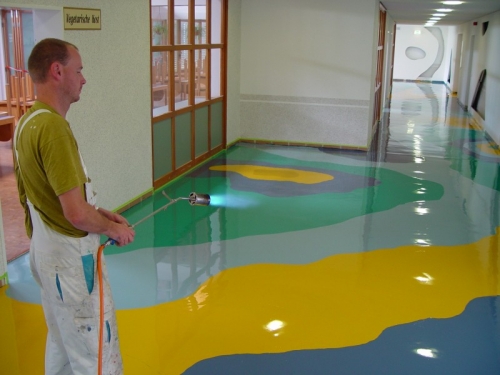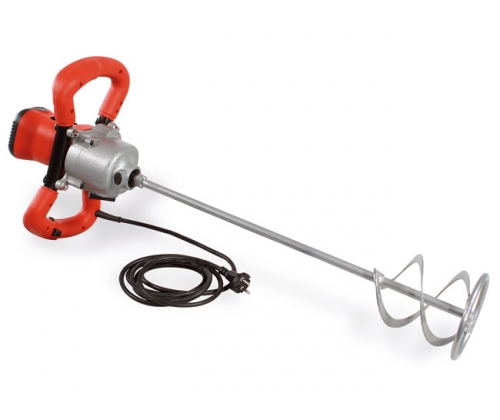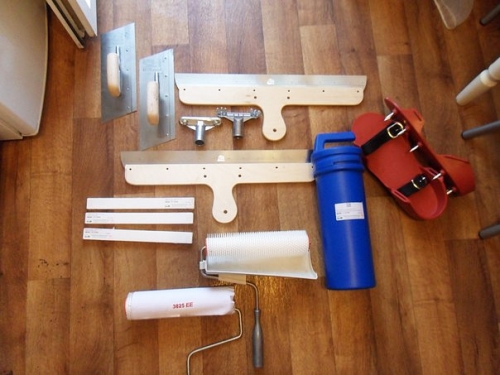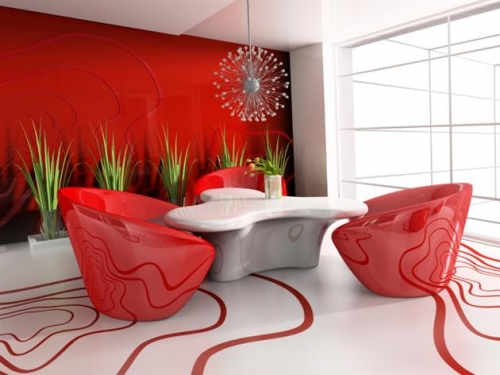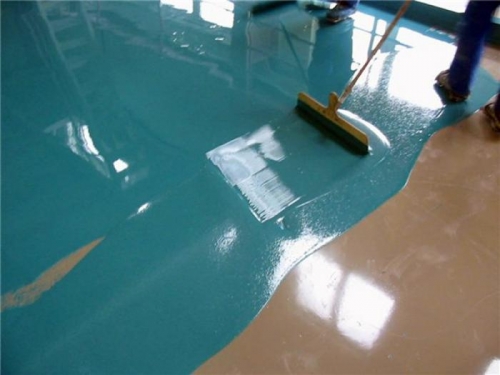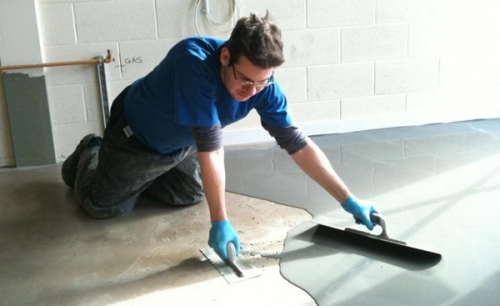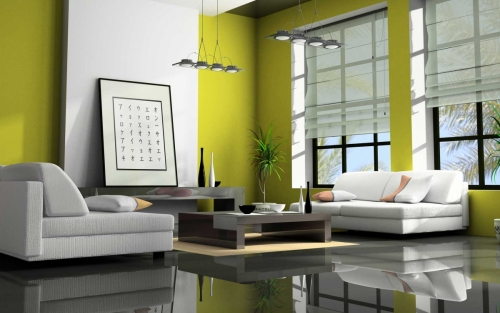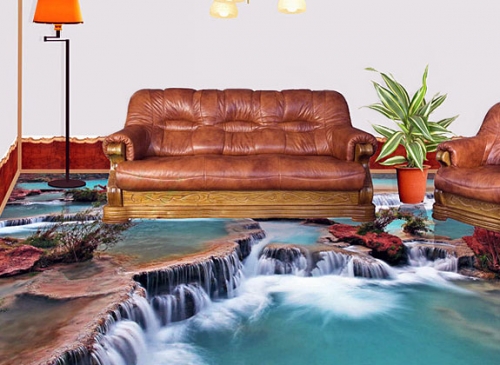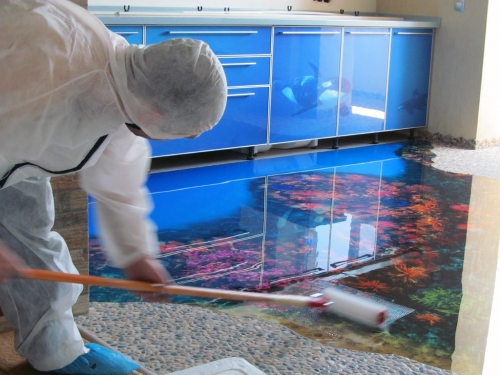The basement plays an important role for every homeowner, and it doesn’t matter where he ...
|
|
The basis of any house is its foundation. When creating this structural element ... |
Before proceeding with the finishing measures, it is necessary to conduct ... |
DIY flooring polymer coating
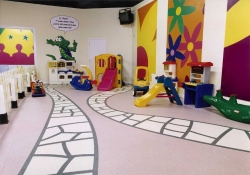
Most homeowners who plan to repair or arrange flooring are trying to focus on modern technologies and the most popular design solutions. Often, in the process of choosing the flooring, one has to face a number of difficulties, since modern flooring should meet many characteristics and be appropriate even in rooms where the flooring will be subjected to a whole set of harmful effects from chemical to abrasive, without losing its decorative effects and hygienic characteristics. All these requirements are met by a polymer coating for the floor, which is very popular on modern construction sites and is characterized by high operational characteristics. Polymer floors, also called liquid linoleum, are a seamless finish polymer flooring applied to a concrete base, cement-sand screed, ceramic tiles or wooden floor. Polymer floors, being a high -tech modern flooring, have all the characteristics that are not characteristic of concrete, nor linoleum, or ceramic tiles and relevant at the present stage of design development. Despite the fact that previously polymer floors were considered only in the context of industrial premises, today, thanks to the use of modern technologies in the process of their production, they have become relevant in residential premises. Due to the relevance of the polymer flooring, this article will consider its main varieties, their brief characteristics, as well as advantages and disadvantages.
Content
- Varieties of bulk floors: Brief description
- Polymer flooring: advantages and disadvantages
- Paul polymer coatings: step -by -step guide
- Features of the arrangement of 3D sex
- Precautions in the process of arranging a bulk floor
Varieties of bulk floors: Brief description
Mineral bulk coatings
The demand for the bulk floor is partly due to the wide choice of its varieties presented in the construction market. Modern manufacturers offer two main varieties of bulk coating: mineral and polymer. Mineral bulk coating is a cement mixture supplemented by a number of fillers, which largely determine its operational characteristics. The mineral bulk floor is a leveling composition, which is used to prepare the surface immediately before laying ceramic tiles, linoleum, laminate and other flooring.
There are three types of mineral mixtures:
- The basic mixture intended for the initial leveling of concrete and cement surfaces, the slopes of which reach 80 mm. The leveling of the surface with the basic mixture is not final, since it is necessary to make its additional adjustment using mixtures for the middle layer;
- The average mixture is used as the main composition for leveling surfaces characterized by slopes of not more than 30 mm;
- The finish mixture is designed for the final leveling of the bases on which the flooring is laid.
Polymer bulk coatings
Another variety of bulk floors polymer coatings is no less popular. They are characterized by the predominant use in rooms where increased requirements, such as resistance to mechanical and chemical influences, lack of abrasion and environmental safety, are presented to the flooring. There are several relevant classifications of polymer coatings that group the types of polymer coatings in accordance with a certain sign. Most often, polymer coatings are classified taking into account:
- Binder component used in the mixture;
- The degree of filling and the thickness of the material.
Consider the main varieties of polymer coatings for the concrete floor.
In accordance with the used connecting component, the following types of polymer coating are distinguished:
- Epoxy polymer coating For the floor, it is characterized by moisture resistance, high strength and resistance to the mechanical and chemical effects of acids, alkalis and oils, which not every floor covering can boast. The use of epoxy coating is relevant only of closed premises in which certain sanitary and hygienic requirements are established. It is in them that the conditions of the intensive effects of mechanical loads and aggressive fluids are created;
- Epoxy uretane mixtures, the use of which is justified only in rooms characterized by intensive movement, such as platforms and parking. Being high -strength compositions resistant to abrasion, they retain their elasticity throughout the entire period of operation;
- Polyurethane bulk coating It is characterized by high wear resistance, resistance to high temperatures and chemicals, which determines the long period of coating, reaching 20 years. A distinctive feature of polyurethane floors is smooth and lack of seams, thanks to which they will never turn into a vacuumber. This is the basic principle of their high aesthetics. Given these features, it should be noted that the polyurethane bulk floor is an ideal choice for rooms characterized by constant vibration load and floor mobility, as well as a frequent abrasive effect on the flooring;
- Methyl methacrylate coating It is characterized by the least popularity, due to the difficulties arising in the process of laying it. Despite the fact that methyl methacrylate coating is characterized by minimal resistance to mechanical loads, it still remains out of competition for unheated rooms.
Given the above, we can conclude about a wide variety of polymeric materials to cover the floors. Despite the fact that the connecting component of the polymer composition largely determines its operational characteristics, it is not the only factor on which they are guided when choosing a bulk coating.
Important!Another important parameter characterizing the bulk coating is thickness. During operation, an annually from the surface of the polymer coating is erased by a polymer layer of a certain thickness, which is determined by the composition of the polymer, as well as the intensity of the load and varies within 10-30 microns.
In accordance with the thickness and degree of filling the coating, the following categories of polymer coatings are distinguished:
- Thin -layer polymer coatings(thickness usually does not exceed 0.5 mm), according to the method of application also called painting, are characterized by a minimum operational period and predominant use in rooms with minimal cross -country ability, and, consequently, mechanical load;
- Burning, also called self-universal, being the most popular type of flooring, are characterized by a thickness of 4-5 mm, the degree of filling up to 50 % and universal operational characteristics;
- Highly filled coatings (average thickness indicators of 4-8 mm, but can reach 20 mm) are characterized by the degree of filling up to 90 %, which determines their prolonged resistance to high mechanical loads.
Polymer flooring: advantages and disadvantages
Despite the unpretentiousness of the polymer coating, it is still one of the most aesthetic options for flooring in any room. The name follows that the flooring includes polymaterials included in it in the form of liquid and undergoing polymerization during its technological processing. Thanks to this feature, the surface is perfectly flat and homogeneous.
Important! Due to the rapid polymerization of the composition, the operation of the floors can be carried out within a short period of time from the moment of laying the flooring.
Advantages of polymer coating:
- High elasticity, which determines the stability of the flooring to intense shock loads;
- Resistance to constant exposure to low temperatures, thanks to which polymer compounds can be used to arrange flooring on open trading floors, to lay flooring on the territory of commercial organizations of various destinations, as well as in freezers;
- High wear resistance, the determination of the ability to withstand prolonged mechanical loads without loss of initial performance;
- Resistance to increased humidity and chemicals;
- Long -term operational period, which may exceed 40 years;
- Unpretentiousness in departure of flooring can be carried out using ordinary water, without the use of special cleaning agents;
- Non -toxicity and fire safety;
- High aesthetic characteristics, lack of seams and absolute smoothness of the coating. The polymer coating acquires additional decorativeness of the surface and a unique special effect due to 3D-varnish. Moreover, modern manufacturers offer a polymer coating with a textured surface and an original pattern.
Disadvantages of the polymer coating:
- In the process of preparing the surface, which takes a fairly long time, you can encounter difficulties;
- The polymer coating is characterized by a long operational period, during which it can morally become obsolete or get bored with the owner;
- Difficulties arising in the process of removing the flooring;
- Polymer flooring steamenability;
- Polymer flooring belongs to a fairly high price category, due to the high cost of component materials that are part of the polymer coating;
- Despite the relevance of the previous paragraph, the market also presents the cheaper varieties of polymer coating, but they are prone to rapid yellowing on the action of ultraviolet radiation;
- Compared to traditional flooring, the design of polymer materials is not large enough;
- During the repair of polymer flooring, difficulties may arise, since increased aesthetic requirements are presented to it. Thus, if you are faced with the need for local repair, difficulties will arise when selecting the necessary color scheme.
Important! Polymer floors designed for laying on a concrete base and characterized by the lack of active waterproofing will soon be exfoliated, due to the evaporation of groundwater, which rise along the natural capillaries of concrete plates.
Paul polymer coatings: step -by -step guide
In order to avoid repairing the polymer flooring, providing it for a long operational period, in the process of arranging the bulk floor it is necessary to clearly follow the recommendations of specialists. If you observe all the technological stages of the flooring device, this process will seem to you quite simple.
Materials and tools for arranging a bulk floor
You will need: to arrange a bulk floor:
- Several plastic buckets with a volume of 30 liters;
- A drill equipped with a meal mixer and characterized by a small number of revolutions (not more than 300);
- Rostish roller and spatula;
- A special needle roller designed to remove air bubbles. The required number of tools is determined by the area of \u200b\u200bthe premises by an average of 40 square meters. m of the room will require one roller;
- A rocket with the installed gap, which will be required to uniform distribution of the mixture on the surface;
- The paintings that will be required to move on a freshly laid floor;
- The solvent with which you will clean all the tools after work.
Preparation of the base is the responsible stage of the arrangement of the bulk floor
It is important to carefully consider this stage of the floor arrangement, since otherwise, if there are irregularities of the base, this will cause deformation of the flooring and its subsequent damage. The technology of preparatory work from the initial state of the base and material from which it is manufactured.
Preparation of a concrete foundation
- Carry out verification of moisture of the base, which should not exceed 4 %;
- If you lay a new base, before laying the bulk floor should pass at least 28 days;
- If you are dealing with an old concrete base, remove the old flooring, clean the surface of pollution, removing the remaining mastic, paint, glue and oil spots;
- Clean the concrete base from dust and fill all the existing irregularities, cracks and potholes with a construction solution with the addition of resin. If small cracks and tears are found, it is recommended to use an adhesive solution. For masking and removing the smallest defects, use a grinding machine;
- Using a horizontal rail-level, check the horizontal surface.
Preparation of a wooden foundation
- Check the moisture content of a wooden base, it should not exceed 10 %;
- Remove the plinths, since new coating will be installed during the installation of the flooring;
- Clean the surface from varnish, paint and glue with a spatula, metal brush or grinding machine;
- Expand the cracks and clean the floor with sandpaper, which will increase the surface adhesion;
- Using an industrial vacuum cleaner, remove the remaining dust and degrease the surface with a cleaning powder;
- Comers the wooden floor with a cement screed or lay out cracks in the construction solution.
Paul filling: recommendations of specialists
- The air temperature in the room in which the floor will be filled should be from +5 to +25 degrees, and humidity is not more than 60 %.
- Any mixture for pouring a polymer coating for the floor in a garage or any other room is two -component, and therefore, they must be mixed in a clean bucket using an electric drill.
- The application of the polymer mixture must be carried out only after the final drying of the primer, which will take about a day. It is recommended to start filling the mixture with the highest surface point. To do this, the prepared polymer mixture is poured on a primed base and with the help of a gear roller is distributed over the entire surface of the base. In the case of the formation of bubbles, remove them using a needle roller.
- The coating thickness should not exceed 1.5 mm on average, but in some cases it can be increased to 5 mm.
- To move on the floor, you will need spray strokes. After waiting for the final drying of the first layer, proceed to applying the second, after which, after 12 hours, apply a layer of varnish.
Polelomic flooring technology of floors
- Pour the finished solution to the floor surface and distribute it throughout the area. To make the distribution more uniform, each subsequent portion of the mixture is distributed near the previous one using a wide spatula. To adjust the thickness of the applied mixture, use a rocket;
- To remove air bubbles that have fallen into the solution, use the needle roller, leaving them on the surface of the floor;
- Pour the next portion of the solution and comb it, thus carrying out the pouring of the coating over the entire area of \u200b\u200bthe floor;
- Having completed the work, cover the floor surface with plastic wrap, which will prevent dust from getting on the floor that has not yet been frozen, and will also make drying more uniform;
- To increase the decorative characteristics of the polymer coating, apply polyurethane varnish on its surface.
Features of the arrangement of 3D sex
The decorative option for a polymer flooring is a 3D-floor, which is a three-layer structure that includes three layers:
- Base layer;
- Picture;
- The final protective layer.
- Installation of 3D coverage in general does not differ from the installation of the traditional polymer flooring. The first stage of installation is also the preparation of the base and is carried out in accordance with the above recommendations for the bulk floor;
- To arrange the base layer, it is recommended to use a polymer coating or floor screed. At the same time, it is important to determine the features of the future decor. Depending on whether it will be small or large, the color scheme of the polymer coating is selected. If the decor is characterized by the presence of a small pattern, the polymer coating will perform the function of the background surface, which necessitates the responsible attitude to the selection of the color palette;
- One of the most critical stages is the application of the image. If you plan to stick the selected picture, select the image so that its sizes are slightly exceeding the floor area;
- Sticking the picture is carried out only on a perfectly flat surface. At the same time, ensure that not a single bubble forms in the process of gluing;
Important! To apply a complex artistic drawing, use the services of professional artists.
- To fix the resulting image, apply a thin layer of varnish.
- The thickness of the final protective layer should not exceed 0.5 mm. To apply it, as in the case of a traditional bulk floor, a gear roller is used, and to smooth the resulting air bubbles needle. The operation of a polymer 3D floor can be carried out in a week.
Important! One of the main difficulties that you may encounter in the process of arranging a 3D floor is the formation of bubbles. Their appearance may be due to factors such as increased coating humidity, poor -quality mixing components and improper preparation of the mixture. To avoid this, it is recommended to use an electric drill equipped with a mixer nozzle to mix the components of the mixture. To make sure that the moisture content of the concrete surface is at the optimal level, use a plastic film, laying it on concrete and gluing with tape. If after three days the film remained dry, you can start filling the mixture.
Precautions in the process of arranging a bulk floor
- In the process, use protective glasses and gloves;
- Avoid the mixture entering open areas of the skin, as this can cause irritation;
- Take care of effective ventilation in the room where the fill will occur, since the mixture has a sharp specific smell;
- If you want to give the floor shine, use special chemicals;
- The usual cleaning of dust and pollution can be carried out using running water.

